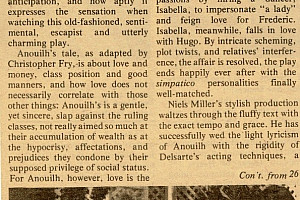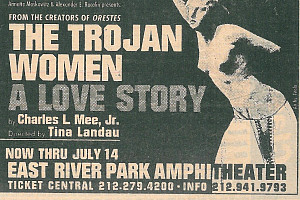Walking Tour with William B. Harris
-
The Papers.
Born in Pittsburgh in 1951, William B. (“Billy”) Harris settled in New York City upon graduation from Trinity College in Hartford, Connecticut, in 1969. A freelance performing-arts critic, he reviewed performances for numerous area newspapers collecting a file of clippings, programs, advertisements and correspondence as he did so. Upon his death in 2000, his family donated his research files to Marymount Manhattan College. Friends added to the initial deposit. The files allow us to take a time-traveling walking tour through Lower Manhattan, to join Billy Harris at memorable theatre and to watch as the increasing traffic visiting downtown for cultural events sets the stage for the revival of the area as a residential, cultural, and shopping district.
-
A Word About the Walking Tour
Constructing this virtual time-traveling walking tour started with reading Billy Harris’s reviews. Some of those reviews contained special surprises for Marymount Manhattan readers. The man on the left in the photo above is -time MMC adjunct professor Dan Diggles. Harris’ reviews always noted the where the performances took place, so that one may still visit the places today. The reviews’ descriptions of scripts, actors, and sets led back to Harris’ research files, and to more information about the performances and their settings. The addresses also led to New York City’s Building Information System and its Department of Finance. Both of these sites maintain data that allow one to see the change in the condition and the value of the building over time. Thus one can study the neighborhood along with the performance.
-
East River Park Ampitheatre: An ancient tradition revived.
On a summery evening in June 1996, William Harris attended a performance of En Garde Arts’ production of The Trojan Women: A Love Story, by Charles Mee, which combined an ancient Greek tragedy about the end of the Trojan War with Virgil’s love story of Aeneus and Dido. Harris was fascinated by the venue, a 1939 New Deal project overseen by legendary Parks Commissioner Robert Moses. The building had suffered greatly during New York’s 1970s financial crisis. During the first act, the audience went backstage, where vandalism added to the feeling of being in post-war Troy. For the second act, the audience sat on wooden benches under the stars and near enough to the river to hear the boats, a romantic setting for the Aeneus-Dido relationship to unfold. Since then, the New York City Department of Parks and Recreation has rebuilt the East River Amphitheater. The city regularly schedules music, dance, and theatrical performances there.


